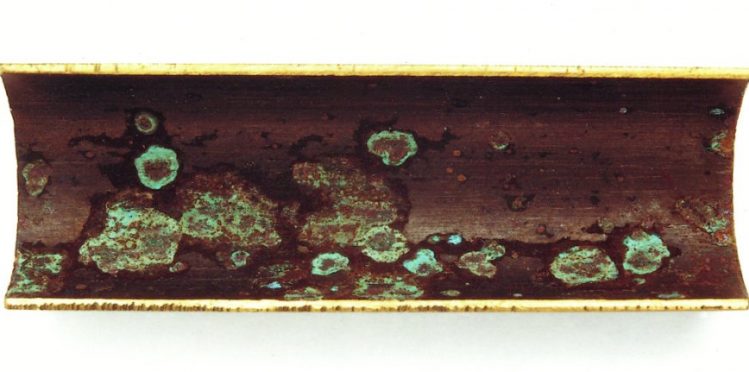
SRB stands for Sulfate Reducing Bacteria. SRB bacteria is one of many common soil bacteria species that populate our world and perform a valuable ecological role in the environment. SRB lives throughout our ecosystem and can be found in almost any puddle or natural body of water, as well as in the soil around us. While most bacteria are aerobic and require oxygen to survive, SRB is among a group of species that is anaerobic and thrives only in the absence of oxygen. SRB and other anaerobic species have adapted to the oxygen in our atmosphere and in natural waters. These species can survive exposure to oxygen by encasing themselves in a slime coat that protects them from the potentially lethal oxygen. While SRB performs an important function in the wild and does not present a danger to humans or other animals, its effects can cause damage to certain metals in cooling towers, closed loops and even boilers.
As covered extensively in our other technical bulletins, the potential health risks of Legionella pneumophila are serious and require an on-going water management program to prevent problems.
This bulletin focuses primarily on bacteria that will corrode metal in water systems. One of the most elusive bacterial problems is Sulfate Reducing Bacteria (SRB). SRB is one of many common soil bacteria species that populate our world and perform a valuable ecological role in the environment. SRB lives throughout our ecosystem and can be found in almost any puddle or natural body of water, as well as in the soil around us.
While most bacteria are aerobic and require oxygen to survive, SRB is among a group of species that is anaerobic and thrives only in the absence of oxygen. SRB and other anaerobic species have adapted to the oxygen in our atmosphere and in natural waters. These species can survive exposure to oxygen by encasing themselves in a slime coat that protects them from the potentially lethal oxygen.
While SRB bacteria performs an important function in the wild and does not present a danger to humans or other animals, its effects can cause damage to certain metals in cooling towers, closed loops and even boilers.
While it is true that cooling tower water is saturated with oxygen, SRB and other anaerobic species such as Clostridium can survive in the oxygen-free deposits that can accumulate in cooling towers. As these deposits accumulate, aerobic bacteria quickly consume all of the oxygen.
An anaerobic condition develops since water cannot circulate through the deposit to supply more oxygen. This is why it is important to eliminate “dead legs” from all water systems. “Dead legs” are portions of the system in which water is allowed to stagnate. When anaerobic bacteria detect the lack of oxygen, they enter their active growth phase and begin to multiply.
SRB colonies can attack all types of ferrous metals including iron, mild steel, galvanized and stainless steel. SRB’s metabolic process uses the conversion of iron to iron oxide to create energy. Clostridium excretes hydrogen ions which react with water to form strong organic acids.
Both types of bacteria result in pits on the surface of the metal that are hidden under tubercles of iron oxide. These tubercles, or corrosion nodules, protect the anaerobic bacteria from the oxygen that would quickly kill them. The tubercles also give away the presence of anaerobic bacteria and Microbiologically Influenced Corrosion, or MIC, which is occurring.
Keeping your surfaces clean is the best defense against SRB bacteria, Clostridium, or any other anaerobic bacteria, because without deposits to hide under, these bacteria are kept in check by the oxygen-rich water in your cooling tower. In general, when the depth of the deposit in your cooling tower exceeds ½”, MIC problems will tend to develop. The appearance of corrosion nodules “growing” in your sump or elsewhere in the system is also a bad sign.
Yes. The earlier we can detect the activity of anaerobic bacteria, the better job we can do at protecting your equipment from its harmful effects. A routine cooling tower and sump cleaning program will help prevent MIC. An annual chiller inspection and brushing will help keep MIC from occurring in this expensive component.
Biopenetrants such as Chardon Filmex 100 can be used to penetrate corrosion nodules and mud deposits to deliver oxygen-rich water and biocides directly to the bacterial colonies. After the elimination of the bio-film, Chardon will recommend an effective oxidizing or non-oxidizing biocide program to prevent MIC by preventing protective biofilms from developing.
Applications vary and so do the products we recommend to address the problem situations. Because of workplace and environmental safety, we highly recommend calling us before to administer biocides. Some states even require licensing to dispense biocide.
There are many considerations. We have products that are good all-around treatment for maintenance doses, as well as treatments for more severe problems. We will put your system on a regimen and repeat the treatment program as needed until control is maintained. We may also recommend alternating daily with a strong halogen like chlorine or bromine to improve control. But, as with most chemicals, it is ill-advised to administer certain chemicals at the same time.
Most closed-loop systems use oxygen scavengers to prevent corrosion. The nature of this type of treatment creates the anaerobic conditions that permits SRB bacteria to thrive. Fortunately, there is little opportunity for anaerobic bacteria to enter a closed loop since there is no contact with air or other sources of bacteria. Still, there are occasionally cases where anaerobic bacteria have caused significant MIC damage to closed-loop systems.
If you have questions about this or any other technical matter, call us at 888-486-9263, or fill out our online contact form here. To learn more about cooling towers and how we treat them, check out our Cooling Tower page for more information.